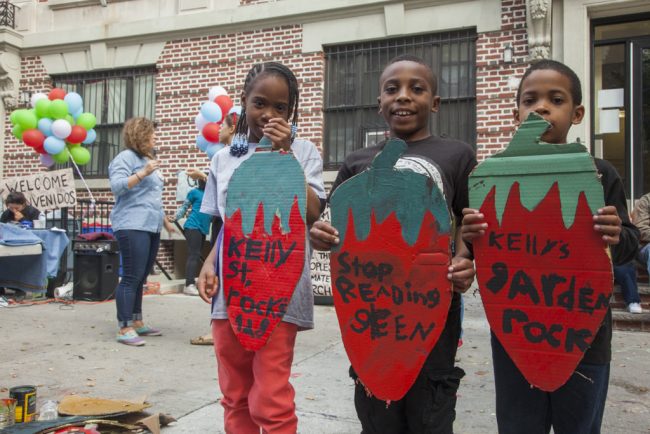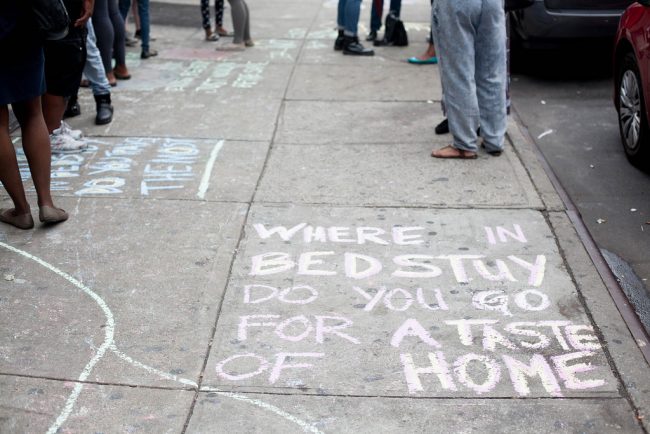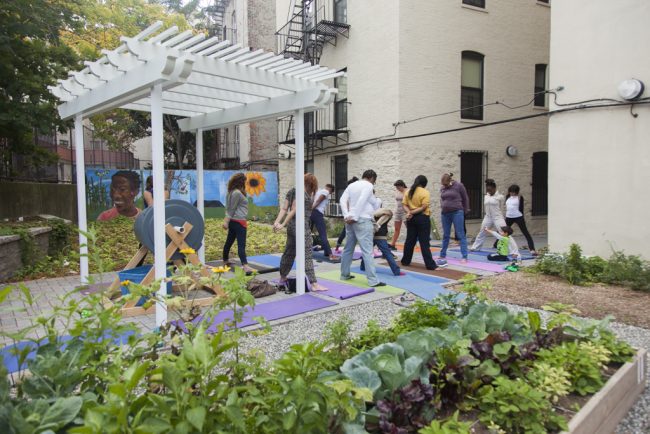
We are celebrating 15 years — and counting — of stories that are deeply researched and deeply felt, that build a historical record of what the city has been.
We are celebrating 15 years — and counting — of stories that are deeply researched and deeply felt, that build a historical record of what the city has been.

Field Day 2014 participants showing off their work | Photo by Melisa Salas, courtesy of the Laundromat Project
“Urbanism” suggests a litany of definitions, including, as Mariel Villere pointed out last year on UO, a growing number of offshoots. The ever-expanding urbanist lexicon — tactical urbanism, ecological urbanism, liquor store urbanism, queer urbanism — can add another permutation to the list: laundromat urbanism.
When Risë Wilson founded the Laundromat Project in 2006, she wanted to exercise communities’ existing beauty and creativity to challenge a wide range of social inequities — with regard to race, class, gender, and environmental justice — in the service of community development. To do so, the Project relies on places like the laundromat, a unique, everyday space that caters to a diverse cross-section of New Yorkers. By embedding art practice in these spaces, the Project aims to generate a new level of pride of place among residents and increase public understanding and engagement with relevant issues.
What this looks like among the washers and dryers is as varied as a laundromat’s clientele. Claro de los Reyes’ My Baryo, My Borough collects and celebrates the histories of the Filipino/Filipino-American community in Queens. Some projects take on the effects of gentrification: in My Very Own Porch on Ipanema Corner, LaTasha N. Diggs created a platform for neighbors to share their perspectives on the transformation of Harlem through video documentary and prose. Another artist, Suran Song, led a yoga class inside a Jackson Heights laundromat and invited residents to make prints inspired by the practice to be installed in the space.
While laundromats provide a vivid example of the kind of spaces the Project aims to engage, the typology does not limit its work. Each year, the Project hosts Field Day: A Festival of Neighborhoods, one way it brings place-based art to any and all communal and public spaces. The studio visits, free art workshops, creative walks, and other events that make up the festival highlight the Project’s focus communities of Bed-Stuy, Harlem, and Hunts Point.
Check out some UO-handpicked Field Day highlights below, and come join us over the next two weekends in celebration of three of New York’s finest neighborhoods.
Harlem: September 19, 1-5PM
Artist Project: Dioko, by Elvira Clayton
The Laundry Room, 143 West 116th Street
Dioko, meaning “connections” in Wolof, celebrates West Harlem’s Senegalese community through an interactive public installation and collection of stories and pictures.
Harlem, I Am Still Here
Frank White Memorial Garden, 512 West 143rd St
Laundromat Project Create Change Fellows will lead participants in an investigation of the cultural importance of Harlem through art-making and discussion around the concepts of displacement and home.

Field Day 2014 – Bed-Stuy | Photo by Ed Marshall, courtesy of the Laundromat Project
Bedford-Stuyvesant: September 20, 1-5PM
Creative Walk
Sincerely, Tommy, 343 Tompkins Avenue, departs at 2PM
One way to gain perspective on a place is to try on the view of an entirely different species. Join Chloë Bass for an exploratory walk through Bed-Stuy inspired by the neighborhood’s stray cats.
Hunts Point/Longwood: September 26, 1-5PM
Artist Project: StoryBlock, by Alison Kibbe and Sasha Phyars-Burgess
Kelly Street Garden, 924 Kelly Street
Part oral history, part multimedia archive, StoryBlock celebrates the Kelly Street community in Longwood. Artists Alison Kibbe and Sasha Phyars-Brugess will lead neighbors in interactive storytelling.
Bronx Brilliance: Art, Activism + Action
Serrano Galleries, 835 Dawson Street
Mappers unite! Laundromat Project Create Change Fellows invite you to join them in community resource mapping and other activities to develop their community-curated art show celebrating the Bronx.
Visit the Laundromat Project website for more information on the activities above and the full slate of Field Day events.

Field Day 2014 – Hunts Point/Longwood | Photo by Melisa Salas, courtesy of the Laundromat Project
Ben Pardee is an urbanist, hip-hop enthusiast, and yogi. He is a project assistant on Urban Omnibus and blends his deep Texan pride with Yankee sensibilities.
The views expressed here are those of the authors only and do not reflect the position of The Architectural League of New York.